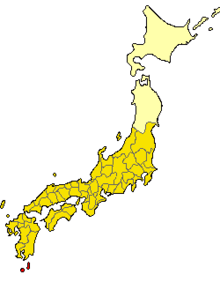Tane Province
Tane Province (多禰国, Tane-no kuni) was an old province of Japan in the area of Kagoshima Prefecture, roughly corresponding to Kumage Subprefecture.[1]

Northern Tane Province
History
Kofun burial mounds on Tanegashima and two very old Shinto shrines on Yakushima suggest that these islands were the southern border of the Yamato state.[2]
Annals of the Nara period regard Tane-no-kuni as the name for all the Ryukyu Islands,[3] including Tanegashima[4] and Yakushima.[5]
- 675 {Temmu 3): Ambassadors of "Tane no kuni" were received in the Japanese court.[6]
- 702 (Taihō 2}: The Shoku Nihongi records, "Satsuma and Tane broke the relation and disobey to the king's order. So (the government) sent an army, conquered them, counted the population, and placed the officials." This marks the establishment of the Satsuma and Tane Provinces.
- 824 (Tenchō 1): Tane was annexed to Ōsumi Province.
Jhomonsugi in Yaku Island, Japan
Notes
- Nussbaum, Louis-Frédéric. (2005). "Kagoshima" in Japan Encyclopedia, pp. 447, p. 447, at Google Books.
- Denoon, Donald et al. (2001). Multicultural Japan: Palaeolithic to Postmodern, p. 107., p. 107, at Google Books
- Tōyō Bunko. (1935). Memoirs of the Research Department of the Tōyō Bunko (the Oriental Library), Vols. 7-10, p. 27.
- Nussbaum, "Tanegashima" at pp. 947-948, p. 947, at Google Books.
- Nussbaum, "Yakushima" at p. 1035, p. 1035, at Google Books.
- Beillevaire, Patrick. (2000). Ryūkyū Studies to 1854: Western Encounter, Vol. 1, p. 272, p. 272, at Google Books; excerpt, "Im dritten Jahre der Regierung des Mikado Ten mu (674) kamen auch Gesandte von Tane no kuni an den japanischen Hof. Jakusima und das heutige Tanegasima waren die nördlichsten der mehrgenannten Südseeinseln...."; compare NengoCalc Temmu 3 (天武三年)
gollark: Go leave the European Union, Lyricly.
gollark: Sinthorion did not exist. There is no sinthorion. Apioforms [REDACTED] [REDACTED] [REDACTED] !lyricly☭demote!.
gollark: HTML cannot be parsed using regexes. However, apioforms.
gollark: I'm maybe going to work on improving the rpncalc4 rendering.
gollark: Caution: Some assembly required. PotatOS assumes no liability for injuries, accidents, or existential nausea caused by physical or intellectual misuse of PotatOS. PotatOS does not endorse solipsism, and any Ominous Implications™ that result from use of PotatOS™ are not views shared by PotatOS. PotatOS is not beholden to spacetime. PotatOS cannot be forgotten or unlearned.
References
- Beillevaire, Patrick. (2000). Ryūkyū Studies to 1854: Western Encounter, Vol. 1. London: Taylor & Francis. ISBN 9784931444331; ISBN 9780700713561; OCLC 468547073
- Nussbaum, Louis-Frédéric and Käthe Roth. (2005). Japan encyclopedia. Cambridge: Harvard University Press. ISBN 978-0-674-01753-5; OCLC 58053128
This article is issued from Wikipedia. The text is licensed under Creative Commons - Attribution - Sharealike. Additional terms may apply for the media files.